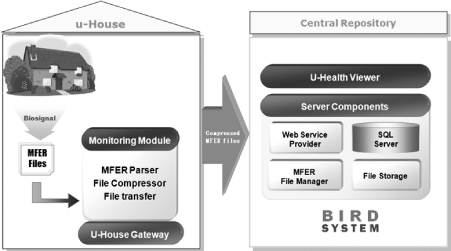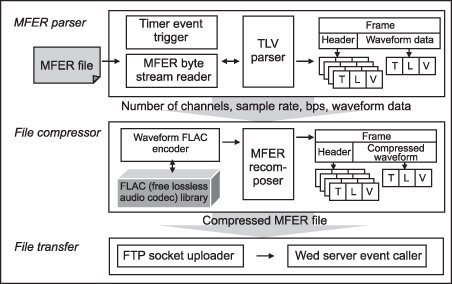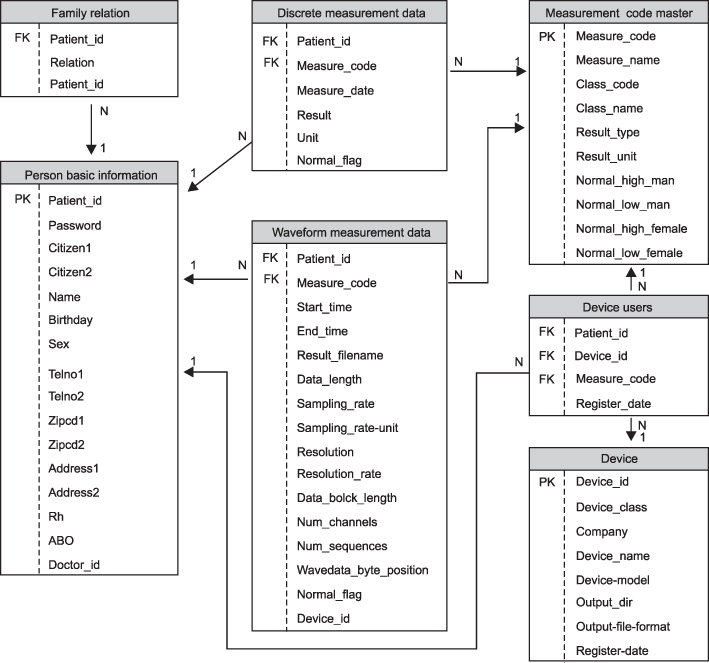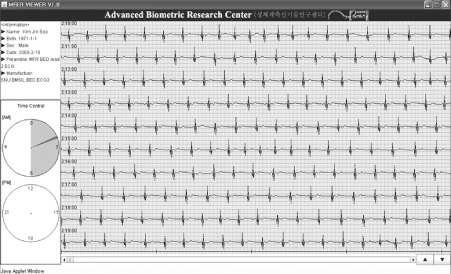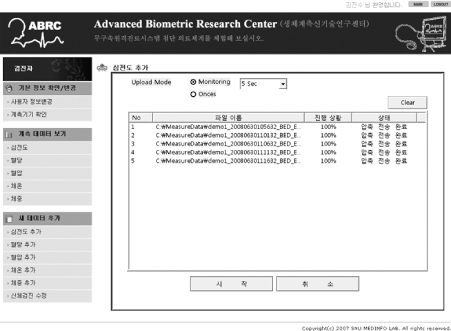J Korean Soc Med Inform.
2009 Dec;15(4):465-474.
Development of u-House Gateway for u-Healthcare
- Affiliations
-
- 1Department of Biomedical Engineering, College of Medicine, Seoul National University, Korea. jinchoi@snu.ac.kr
- 2Interdisciplinary Program of Bioengineering, College of Engineering, Seoul National University, Korea.
Abstract
OBJECTIVE
Ubiquitous healthcare (u-Healthcare) is an emerging paradigm in the healthcare environment. One of the most promising applications for u-Healthcare is the ubiquitous home health monitoring system. This paper addresses two significant challenges in the successful application of the ubiquitous home health monitoring system: the uniform integration of measured biosignal data and easy access to monitored biosignal data. METHODS: We used the Medical waveform description Format Encoding Rule (MFER) standard to encode biosignal data. A web-based MFER upload ActiveX control was designed and implemented to transfer MFER files to the central repository server in a near real-time basis. All of the integrated biosignal data were then accessed and managed through the central repository server. RESULTS: We developed a u-House server that can serve as a uniform data transferer to integrate measured biosignal data from u-House homes into the remote central repository server. We developed user-friendly web services that allow users to easily search and view monitored biosignal data. CONCLUSION: The results of this study suggest that the MFER standard can be easily adapted to u-Healthcare systems and that a web-based ubiquitous home health monitoring system has advantages of ubiquitous access and scalability.
MeSH Terms
Figure
Reference
-
1. Lyytinen K, Yoo YJ. Issues and challenges in ubiquitous computing. Commun ACM. 2002. 45(12):62–65.2. Korhonen I, Parkka J, Van Gils M. Health monitoring in the home of the future. IEEE Eng Med Biol. 2003. 22(3):66–73.
Article3. Lee SH, Shin JW, Sung HM, Yoon YR, Lee KJ. A study on the development of integrated biosignal management system. J Korean Soc Med Informatics. 1998. 4(2):17–23.
Article4. Choi JM, Choi BH, Seo JW, Sohn RH, Ryu MS, Yi W, et al. A system for ubiquitous health monitoring in the bedroom via a bluetooth network and wireless LAN. P Ann Int IEEE Embs. 2004. 26:3362–3365.
Article5. Venkatasubramanian K, Deng G, Mukherjee T, Quintero J, Annamalai V, Gupta SKS. Ayushman: a wireless sensor network based health monitoring infrastructure and testbed. Lect Notes Comput Sc. 2005. 3560:406–407.
Article6. Intel Proactive Health Lab. 2007. Available at: http://www.intel.com/healthcare/hri/pdf/proactive_health.pdf.7. Lukowicz P, Anliker U, Ward J, Troster G, Hirt E, Neufelt C. AMON: a wearable medical computer for high risk patients. 2002. In : Sixth International Symposium on Wearable Computers, Proceedings; 133–134.8. ISO 11073-91064. 2009. Available at: http://www.iso.org.9. Ackerman MJ, Ball MJ, Clayton PD, Frisse ME, Gardner RM, Greenes RA, et al. Standards for medical identifiers, codes, and messages needed to create an efficient computer-stored medical record. J Am Med Inform Assn. 1994. 1(1):1–7.
Article10. IEEE 1073. Available at: http://www.ieee1073.org.11. Kennelly RJ. The IEEE 1073 standard for medical device communications. 1998. In : 1998 IEEE Autotestcon Proceedings-IEEE Systems Readiness Technology Conference; 335–336.12. Galarraga M, Seffano L, Martinez I, de Toledo P, Reynolds M. Telemonitoring systems interoperability challenge: an updated review of the applicability of ISO/IEEE 11073 standards for interoperability in telemonitoring. 2007. In : 2007 Annual International Conference of the IEEE Engineering in Medicine and Biology Society, Vols 1-16; 6162–6166.13. ISO/TS 11073-92001. 2007. Available at: http://www.iso.org.14. Kang EY, Im YS, Kim UM. Remote control multiagent system for u-healthcare service. Lect Notes Artif Int. 2007. 4496:636–644.
Article15. Lee JH, Kim KK, Kim HS, Jeong PS, Jung WS, Oh YH. Implementation of U-Healthcare Monitoring System based on USN. The Journal of KICS. 2008. 33(2):75–81.16. Jung WS, Oh YH. Patient monitoring system based on u-healthcare. The institute of Electronics Engineers of Korea. 2007. 30(1):589–590.17. Park SK, Park SH, Kang MG, Chae YM, Kim SK, Choy S, et al. Wireless Clinical Trial of Data Capture using a Personal Digital Assistant. J Korean Med Informatics. 2009. 15(2):235–244.
Article18. Istepanian RSH, Lacal JC. Emerging mobile communication technologies for health: some imperative notes on m-health. Proceedings of the 25th Annual International Conference of the Ieee Engineering in Medicine and Biology Society, Vols 1-4. 2003. 25. 1414: 1416.
Article19. FLAC. Available at: http://flac.sourceforge.net/.
- Full Text Links
- Actions
-
Cited
- CITED
-
- Close
- Share
- Similar articles
-
- XDS-I Gateway Development for HIE Connectivity with Legacy PACS at Gil Hospital
- Order Communication System Gateway Using HL7 Protocol
- Patient management system gateway using HL7 Protocol
- Development of Biosignal Telemonitoring System Based on HL7 and MFER Standard
- Book Review: Healthcare Analytics for Quality and Performance Improvement

